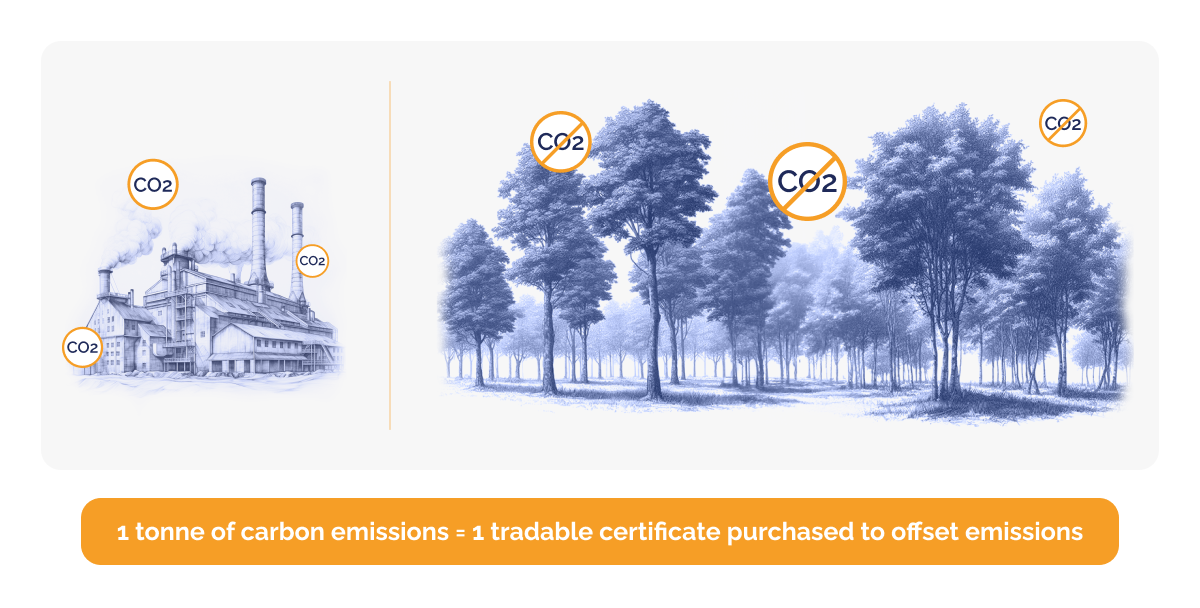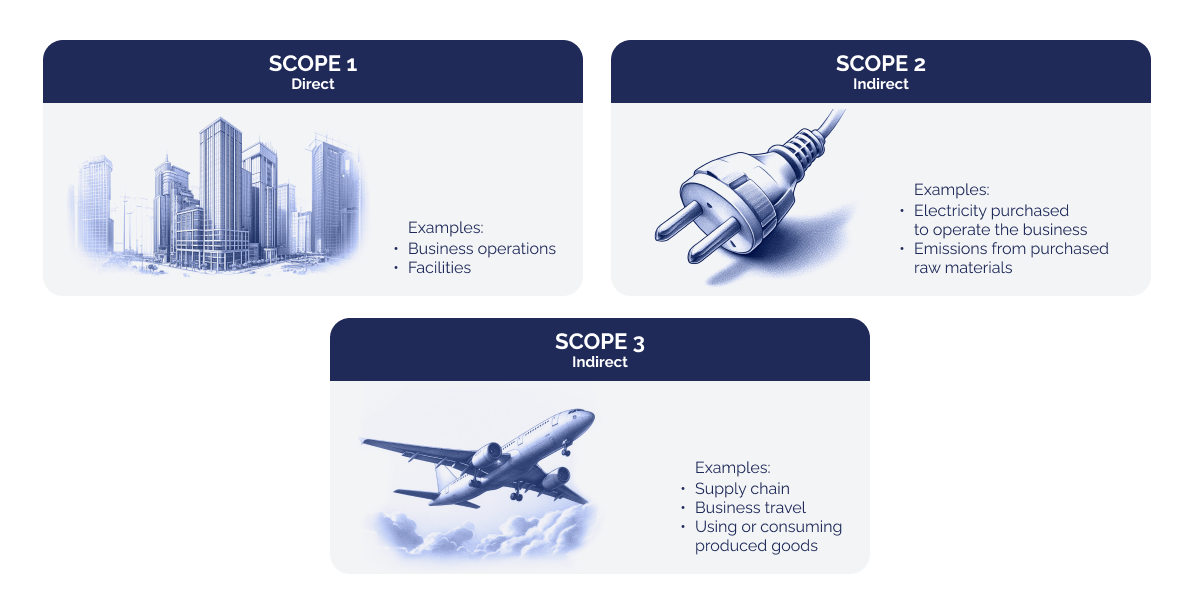Understanding what is a carbon footprint and how your carbon footprint works is the first step in creating a strategy to reduce your carbon emissions and become more sustainable, consequently making a positive impact on your environment.

Close-up of a local man working in a tree nursery.
What is a carbon footprint?
A carbon footprint is the total amount of carbon dioxide (CO2) produced by an operation or an individual, measured in tonnes and usually expressed as an annual amount. CO2 is a greenhouse gas that traps heat within the atmosphere, which increases the global average temperature, thus contributing to changing environmental conditions.
All our actions have either a positive or a negative effect, generally speaking. Similarly, each of our actions and behaviours has either a positive or negative impact on the environment.
This impact is measured in tonnes of CO2. CO2 is, for that reason, the unit of transaction for measuring the positive or negative effects on the environment.

Illustrations describing how carbon certificates work.
It is not uncommon to believe that CO2 is only produced by energy-producing or consuming activities; however, many other factors contribute to carbon footprints.
CO2 is produced by a multitude of activities such as the burning of fossil fuels to generate energy (for electricity use, for instance), manufacturing, food production (specifically meat), driving, flying, plastic use, paper use, waste disposal, deforestation, and improper land use.
Agriculture and logging industries are significant contributors towards the increase of CO2 due to their large-scale removal of trees—our carbon catchers—and the way in which they manage agricultural land that releases CO2 from the soil.
It is thus essential that farmers and loggers understand the impact that they have on nature in order for them to implement strategies to compensate for such negative impacts.
Each individual too plays a role in the amount of CO2 in the atmosphere as a result of their behaviour and actions.
The global average carbon footprint per person for 2020 was 4.47 tonnes. This number can be as high as 37 tonnes per year.
This sizeable variance is due to differences in location, lifestyle, diet, travel, spending, consumption, and whether or not a person recycles.
The amount for corporations and industries is, of course, much higher and varies depending on the type, industry, and size of the operation and the products produced.
Big oil companies, for instance, can contribute millions of tonnes of CO2 emissions per year and thus face the most pressure to reduce their emissions.
Read more: Industry carbon footprints: transport, events, and celebrities
How do carbon footprints work?
CO2 emissions for businesses are categorised into 3 scopes:
- Scope 1 covers CO2 emissions from sources directly owned and controlled by the company, like its buildings, industrial processes, and fuel-burning vehicles.
- Scope 2 covers the CO2 emissions from the generation of electricity, heating, cooling, or steam that a business acquires from a utility provider to power its operations. Therefore, the amount of emissions of the utility provider that can be apportioned to the business.
- Scope 3 emissions are more broad and refers to CO2 emissions throughout the value chain of the business that are not produced by the business but which it remains indirectly responsible for; for example, employee commutes, operational waste, and emissions as a result of the products produced by the company, such as fridges.

Illustrations describing 3 scopes.
All 3 scopes are taken into account when measuring your business's total carbon footprint. Should you wish to measure your carbon footprint and the impact you have on the environment, whether you are an individual or a business of any size, you can use our carbon footprint calculator to get you started on your journey to becoming more sustainable.
Learn how to measure your carbon footprint
Once you have identified the sources of CO2 that you are directly or indirectly responsible for, you will need to consider if you are going to put measures in place to reduce or neutralise your carbon emissions.
Read more: How to use DGB Group's carbon footprint calculator on your journey to net zero
These measures can focus on cutting your emissions where possible and reducing your carbon-emitting activities or purchasing carbon credits (carbon units) in order to compensate for your emissions.
A carbon credit represents 1 tonne of CO2 or carbon dioxide equivalents removed from the atmosphere through nature-based projects focussed on restoring or conserving the environment. When you purchase carbon credits, you fund these nature projects, such as the projects led by DGB Group.
Why do carbon footprints matter to DGB Group?

Bulindi chimpanzee in its natural habitat, Bulindi Chimpanzee Habitat Restoration Project, DGB.
At DGB Group, our goal is to make nature flourish and prosper. We do this by implementing nature-based solutions in the form of carbon avoidance and removal projects that protect and restore biodiversity and ecosystems, conserve nature, and develop habitats.
These projects then generate carbon credits (also known as carbon units) that help individuals and businesses reduce their carbon footprint and achieve environmental goals.
So, if you are wondering how to reduce your carbon footprint, start by measuring your carbon footprint and then compensate for your past or irreducible emissions with carbon units from our nature-based projects. This is a great step towards becoming sustainable and making a positive environmental impact.
Start measuring your carbon footprint
You can also make a positive impact by planting trees. Trees help to catch carbon emissions, create a home for wildlife, regulate water, and purify the air. They are vital in protecting our environment and providing valuable resources.
Why measure or reduce your carbon footprint?
The benefits of reducing your carbon footprint and becoming sustainable are numerous, and each business may have its own motivations for doing so.
Learn how to measure your carbon footprint with our short webinar

Close-up of a local man planting a tree seedling, Hongera Reforestation Project, DGB.
5 Reasons why you should aim to achieve net-zero emissions:
-
Boost your brand. Green companies appeal to the growing environmentally-conscious market. Products that are produced sustainably by companies with environmental commitments are valued higher by consumers and can differentiate you from your competitors, thereby giving you a competitive advantage.
-
Increase revenue. By changing your business's behaviour towards energy consumption and emission-producing activities, you decrease inefficiencies and increase cost-effectiveness, thereby growing your revenue.
-
Be compliant. We are moving towards a low-carbon economy, with governments imposing or proposing to impose climate regulations and emission restrictions. By aligning your business strategy with carbon emission standards, you mitigate the risk of possible future carbon taxes and penalties for non-compliance with these new regulations.
-
Reassure and lure investors. Measuring and reporting on your carbon footprint and emission reduction strategies increases your business's transparency to your investors and stakeholders. This, together with the added corporate social responsibility considerations of being emissions compliant, can align attractively with investor requirements and drive investor decision making.
-
Save the environment. Decreasing your carbon footprint benefits the environment as it lessens the negative impact you have on it. Participating in the movement towards a greener Earth also inspires others to do the same, thereby cumulating the positive effects of carbon sequestration and carbon consideration.
Quantifying and understanding your carbon footprint is, therefore, the first step towards building a sustainable strategy to leave a positive, greener footprint on your environment.








